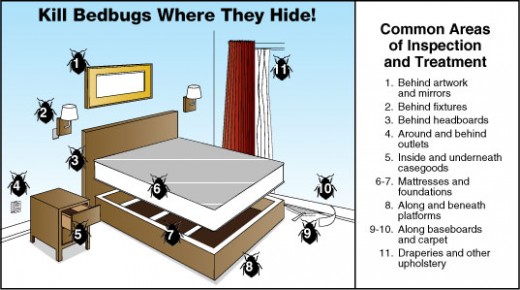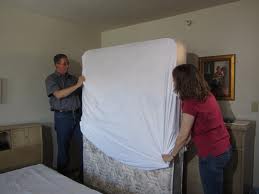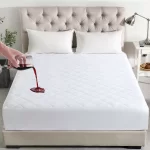
Protecting Your Bedding From Bed Bugs
Bed bugs are notorious for invading our homes and disrupting our peace of mind. These tiny, persistent pests can hide in the nooks and crannies of furniture, particularly in bedding, making them incredibly difficult to eradicate. If you’ve encountered these unwelcome visitors or want to prevent an infestation, this comprehensive guide will show you how to protect your bedding effectively. Click link for info article on bed bugs
From the strategic use of mattress encasements and pillow encasements to employing bed bug-killing powder, we’ll cover the tools and techniques necessary to keep your bedding safe and your sleep uninterrupted.
What Are Bed Bugs?
Bed bugs are small, flat, reddish-brown insects that feed on the blood of humans and animals while they sleep. Although they don’t transmit diseases, their bites can cause discomfort, itching, and even allergic reactions in some people.
Common Hiding Places for Bed Bugs
- Mattresses and box springs
- Pillows and bedding
- Bed frames and headboards
- Carpets and rugs
- Furniture seams and cracks
These pests thrive in warm, dark spaces, making your bed the perfect habitat. Identifying their presence early is crucial for effective management.
Signs of a Bed Bug Infestation
Detecting bed bugs early can save you a lot of time, money, and stress. Here are some common signs:
- Bites: Small, red, itchy bites often appear in clusters or straight lines on your skin.
- Blood Stains: Tiny red or rust-colored stains on sheets or pillowcases from crushed bugs.
- Excrement: Dark or black spots on your mattress, bedding, or walls.
- Eggs and Shells: Tiny, translucent white eggs or shed skins in bedding or furniture crevices.
- Live Bed Bugs: Seeing live bugs in your bedding or furniture.
Why Bedding Protection Is Essential
Since bed bugs tend to congregate near where people sleep, protecting your bedding is one of the most effective ways to combat an infestation. Investing in protective measures like mattress encasements, pillow encasements, and targeted solutions such as bed bug-killing powder can significantly reduce the chances of bed bugs thriving in your home.
Step-by-Step Guide to Protect Your Bedding from Bed Bugs

1. Start with a Thorough Inspection
Before implementing protective measures, inspect your bedding and surrounding areas for signs of bed bugs. Use a flashlight and magnifying glass to check:
- Seams and edges of your mattress and box spring
- Pillow seams and zippers
- Bed frame joints and headboards
- Surrounding furniture, including drawers and closets
2. Use Mattress and Pillow Encasements
Mattress encasements and pillow encasements are specially designed covers that seal your bedding, preventing bed bugs from entering or escaping. Here’s why they are indispensable:
- Barrier Protection: Encasements trap any existing bed bugs inside, effectively starving them over time.
- Ease of Detection: Smooth, white surfaces make spotting bed bugs easier.
- Long-Term Use: High-quality encasements are durable and resistant to tears.
Choosing the Right Encasements
- Look for encasements labeled as “bed bug-proof.”
- Ensure they have reinforced seams and secure zippers with a lock.
- Opt for breathable, hypoallergenic materials for added comfort.
Click link to our Cover and Protect website for mattress & pillow encasements protectors
How to Install Mattress and Pillow Encasements

- Wash and dry your bedding on high heat to kill any existing bed bugs.
- Slip the encasement over your mattress or pillow and secure the zipper.
- Ensure the zipper is fully sealed, as even a small opening can allow bugs to escape.
3. Wash and Heat-Treat Your Bedding Regularly
Bed bugs are sensitive to high temperatures. Washing and heat-treating your bedding can eliminate them effectively.
- Wash: Use hot water (at least 60°C/140°F) to wash all bedding, including sheets, pillowcases, and mattress pads.
- Dry: Dry on the highest heat setting for at least 30 minutes.
- Frequency: Repeat this process weekly to prevent reinfestation.
4. Apply Bed Bug-Killing Powder
Bed bug-killing powders, often made from diatomaceous earth or silica, are an excellent non-toxic solution for tackling these pests.
Click link to purchase bed bug killing powder from our website:
Benefits of Bed Bug-Killing Powder
- Long-Lasting: Unlike sprays, powders remain effective as long as they are undisturbed.
- Safe for Humans and Pets: Most powders are non-toxic when used as directed.
- Effective: They dehydrate and kill bed bugs on contact.
How to Use Bed Bug-Killing Powder
- Identify hotspots: Focus on areas around the bed, mattress seams, and cracks in furniture.
- Lightly sprinkle the powder: Use a brush or duster to apply a fine layer.
- Leave it undisturbed: Allow the powder to work for several days before vacuuming.
- Reapply as needed: Repeat the application after vacuuming or if you notice new activity.
5. Declutter and Organize Your Bedroom
Bed bugs love clutter, which provides ample hiding spots. Simplify your living space by:
- Removing Excess Items: Keep only essential items near your bed.
- Vacuuming Frequently: Use a vacuum with a HEPA filter to clean carpets, rugs, and furniture.
- Sealing Cracks and Gaps: Use caulk to seal crevices in walls, baseboards, and furniture.
6. Prevent Future Infestations
Once your bedding is protected, take these steps to prevent a recurrence:
- Inspect Second-Hand Items: Thoroughly check used furniture or bedding for signs of bed bugs before bringing them into your home.
- Use Protective Covers: Continue using mattress and pillow encasements as a preventive measure.
- Monitor for Activity: Regularly inspect your bedding and surrounding areas.
- Be Cautious When Traveling: Bed bugs often hitch a ride in luggage. Unpack and inspect your bags outside your bedroom after a trip.
Frequently Asked Questions About Bed Bug Prevention
Can Bed Bugs Bite Through Mattress Encasements?
No, high-quality bed bug-proof encasements are designed to be bite-proof. They create a barrier that prevents bed bugs from reaching you.
How Long Should I Leave Bed Bug-Killing Powder in Place?
For best results, leave the powder undisturbed for 5-7 days before vacuuming. Reapply as needed, especially if you notice continued activity.
Do I Need to Treat My Entire Home for Bed Bugs?
While the bedroom is the primary target, it’s essential to treat all areas where bed bugs might hide, such as furniture, carpets, and baseboards.
Conclusion
Protecting your bedding from bed bugs doesn’t have to be overwhelming. By using mattress encasements, pillow encasements, and bed bug-killing powder, along with maintaining cleanliness and vigilance, you can effectively safeguard your home from these persistent pests.
Bed bugs may be tenacious, but with the right tools and strategies, you can reclaim your peace of mind and enjoy restful, worry-free nights.
Please visit our website for sales, and further information on bed bugs




